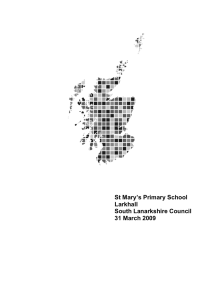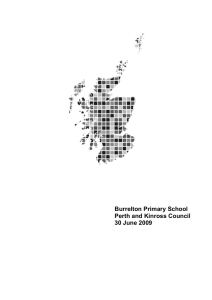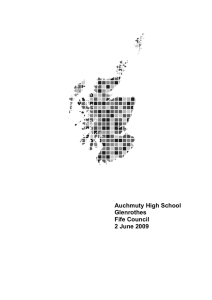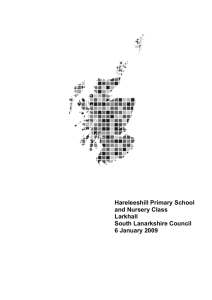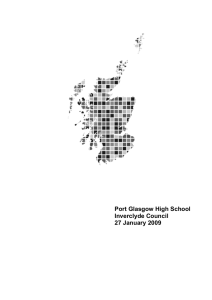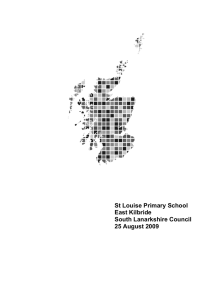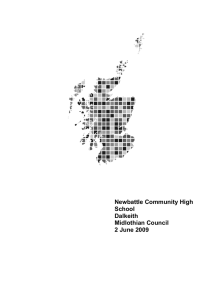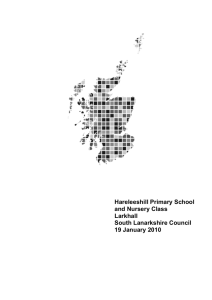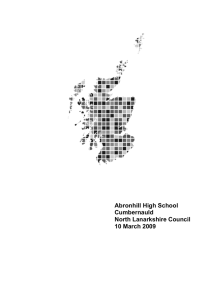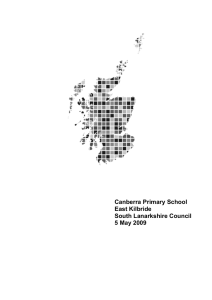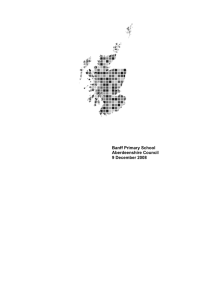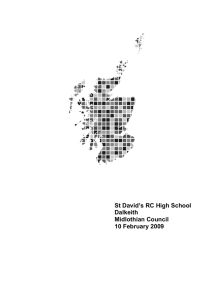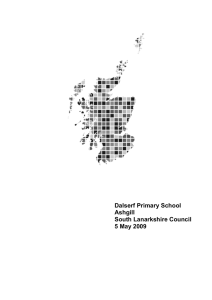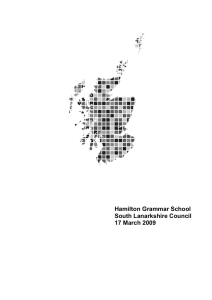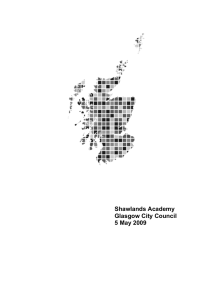Larkhall Academy South Lanarkshire Council 9 June 2009
advertisement
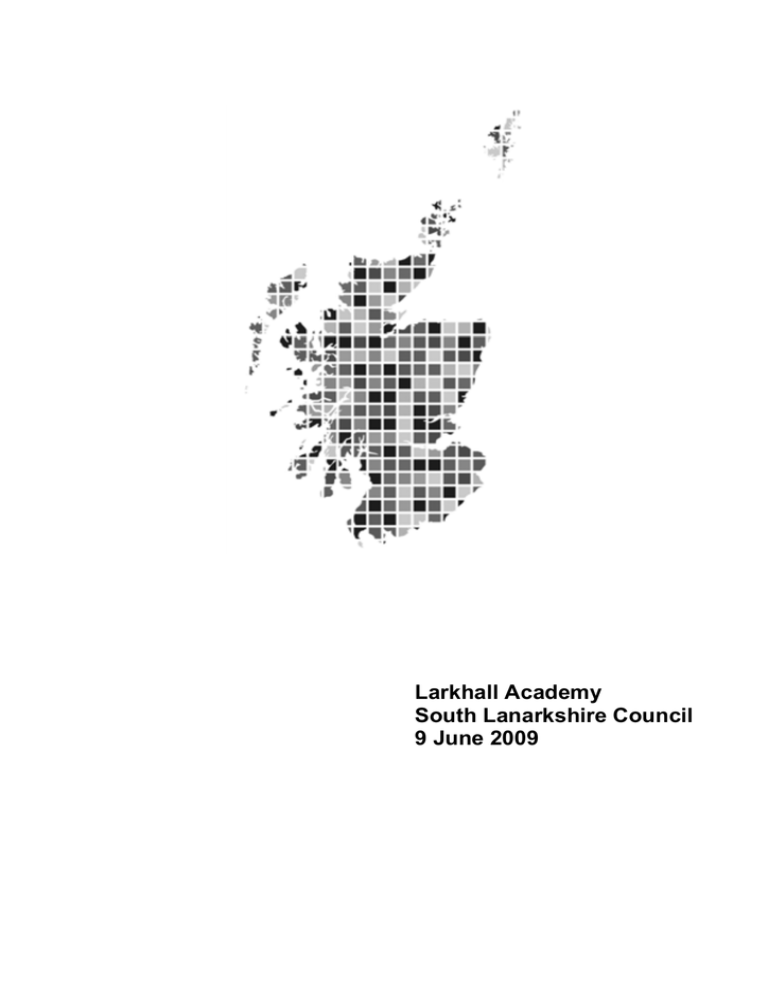
Larkhall Academy South Lanarkshire Council 9 June 2009 We published a report on Larkhall Academy in June 2007. That report set out key strengths of the school and main points for action. We carried out a follow-through inspection in January 2008 and published a report on that visit in June 2008. This follow-through report is based on an inspection visit which was carried out in March 2009. It tells you about improvements since the original inspection in the quality of education which the school provides. It also comments on how the school is getting on with the main points for action. First we focus on changes in the core work of the school. We explain how the school has got better at helping young people to learn and benefit from being at the school. Next we look at the key processes which enable this to happen, including the involvement of parents1. Our report also describes developments in the ‘ethos’ of the school, by which we mean how well young people are cared for and how much is expected of them in all aspects of school life. Finally we comment on improvements in leadership to help the school achieve its aims. A copy of this report has been placed on the HMIE website www.hmie.gov.uk. Where applicable, you will also find descriptions of good practice in the school and analyses of questionnaire returns. 1 Throughout this report, the term ‘parents’ should be taken to include foster carers, residential care staff and carers who are relatives or friends. Contents 1. The school 2. Particular strengths of the school 3. Examples of good practice 4. How well do young people learn and achieve? 5. How well do staff work with others to support young people's learning? 6. Are staff and young people actively involved in improving their school community? 7. Does the school have high expectations of all young people? 8. Does the school have a clear sense of direction? 9. What happens next? 1. The school Larkhall Academy serves the towns of Larkhall and Stonehouse and the adjoining villages of Ashgill and Netherburn. 1 2. Particular strengths of the school • The work of the Assessment is for Learning Group in improving the quality of teaching and of young people’s learning experiences. • The increasing proportions of young people continuing with education and training or entering employment when they leave school. • The work undertaken with gypsy travellers’ children. 3. Examples of good practice • The Gypsy Traveller Creative Learning Group. • Learning through drama. 4. How well do young people learn and achieve? The majority of young people now make good progress. Overall, the curriculum provides a broad and balanced experience for most young people. Most young people are well behaved and willing to learn. They are now experiencing a greater variety of learning and teaching approaches. Most teachers are successfully sharing the purposes of lessons with learners and are setting more challenging and interesting tasks. As a result, more young people are now actively engaged in their learning. These positive changes are not evident in all classes. Overall attainment has not improved. Standards of reading in S1 show some signs of improvement. Performance of young people in national examinations at S4 to S6 has not improved. Young people perform 2 less well than those with similar needs and backgrounds in other schools. Their attainments in national examinations continue to be well below or below national averages on most measures. Results from recent in-school examinations indicate improvements in young people’s performances. The school is improving how it checks and encourages progress. Young people benefit from a wide range of opportunities to achieve through drama, sporting and musical activities. For example, the Concert Band won the Glasgow Music Festival at the Royal Concert Hall for the third year in a row. The Candid Theatre group performed their show based on the Holocaust in the school and the Giffnock synagogue. 5. How well do staff work with others to support young people's learning? Teamwork among staff is much improved. They work well together to support the learning of all pupils, including gypsy travellers’ children and those with additional support needs. Improved monitoring of young people’s progress is helping to clarify where their strengths lie and what their next steps in learning are. Links with associated primary schools are improving through tasks which allow for progression from primary into secondary. Young people are benefiting from the school’s good working relationships with local colleges and support agencies. These increase opportunities for some young people to broaden their learning in a range of areas. These include hairdressing, care, catering and through learning in the world of work. The school should continue to work with its partner organisations to ensure the sustainability of these programmes in the longer term. 6. Are staff and young people actively involved in improving their school community? Young people now benefit from the changes the school has made in how it identifies areas for improvement. Senior managers now undertake a much more rigorous review of examination performance. 3 Members of the senior management team and principal teachers observe lessons and learning on a regular basis. Increasingly, individual teachers arrange flexible and informal lesson observations. The school has clearly set out its self-evaluation expectations for faculties. There is now a much greater sense of ownership of self-evaluation at faculty and classroom levels. Staff are active in the life and work of the community. They take part in groups linked to school improvement and organise activities and support for young people outside school hours. Senior pupils involved in charity work, Prince’s Trust, Peer Training, and other initiatives are highly positive, confident and successful. They are taking increasing responsibility for leading on key projects. Many young people are committed to working with others to improve the school and its community. 7. Does the school have high expectations of all young people? The senior management team are committed to raising young people’s expectations and aspirations. Young people’s progress and achievements are now being carefully monitored and recorded. Staff morale is now much improved and there are clear improvements in teachers’ expectations of what young people can do. Staff display very high commitment to the school and support a wide range of extra-curricular activities. Most pupils respond very well to the opportunities provided and are keen to succeed. Young people’s attendance has not improved and exclusions have risen. 8. Does the school have a clear sense of direction? Capacity for leadership and improvement have increased as a result of positive recent changes within the senior management team. The headteacher now has a vision for the future of the school in the context of the new school building and Curriculum for Excellence. He now needs to draw this together more effectively and communicate it more clearly to staff to provide a coherent, strategic way forward. Senior management are developing a more strategic approach in a range of 4 areas. These include enhancing the curriculum, strengthening joint work with associated primary schools, and developing vocational education across the school. Senior management are establishing greater rigour in the self-evaluation process and are undertaking effective lesson observations. 9. What happens next? There is clear evidence of improvement since the original inspection. There have been significant improvements in a number of important areas. Learning, teaching and meeting needs have improved and there are signs of continuing improvement. Young people’s learning experiences, leadership and the arrangements for self-evaluation are now at a satisfactory or better level. With the continued commitment of staff, and further support from the education authority, the school has the capacity to improve further. The District Inspector will maintain contact with the education authority to monitor continued improvements in attainment. In November 2009, HMIE will ask the education authority for a report on the attainment and achievement of young people. Parents will be informed of progress. HM Inspector: David M Martin 9 June 2009 5 To find out more about inspections or get an electronic copy of this report go to www.hmie.gov.uk. Please contact the Business Management and Communications Team (BMCT) if you wish to enquire about our arrangements for translated or other appropriate versions. If you wish to comment about any of our inspections, contact us at HMIEenquiries@hmie.gsi.gov.uk or alternatively you should write in the first instance to BMCT, HM Inspectorate of Education, Denholm House, Almondvale Business Park, Almondvale Way, Livingston EH54 6GA. Our complaints procedure is available from our website www.hmie.gov.uk or alternatively you can write to our Complaints Manager, at the address above or by telephoning 01506 600259. If you are not satisfied with the action we have taken at the end of our complaints procedure, you can raise your complaint with the Scottish Public Services Ombudsman (SPSO). The SPSO is fully independent and has powers to investigate complaints about Government departments and agencies. You should write to the SPSO, Freepost EH641, Edinburgh EH3 0BR. You can also telephone 0800 377 7330, fax 0800 377 7331 or e-mail: ask@spso.org.uk. More information about the Ombudsman’s office can be obtained from the website at www.spso.org.uk. Crown Copyright 2009 HM Inspectorate of Education
